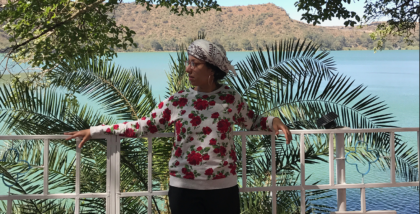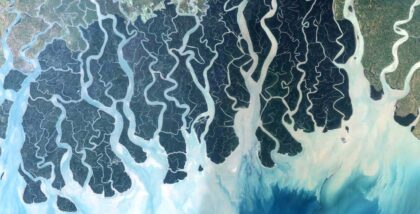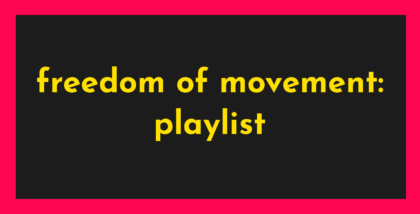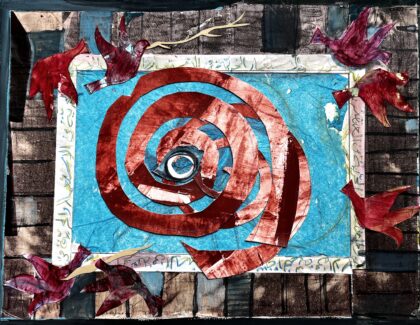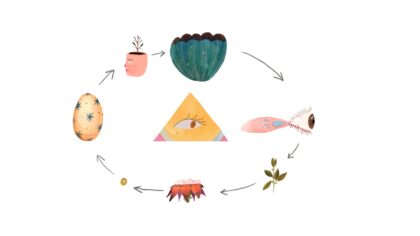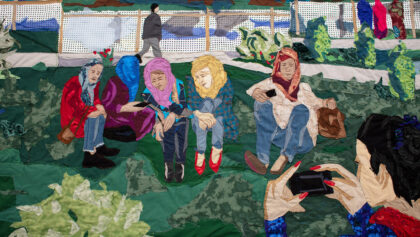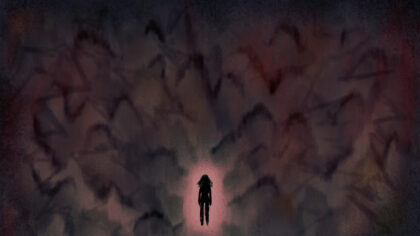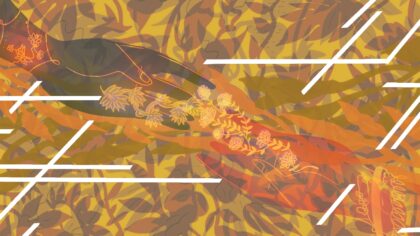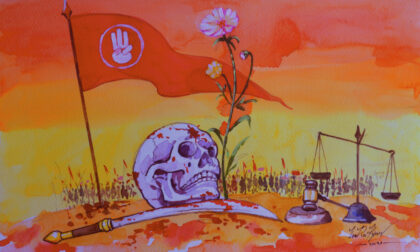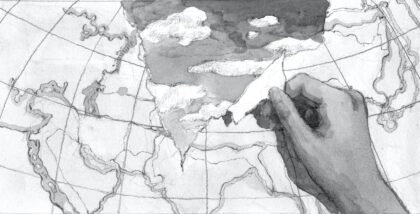 Illustration: Xia Gordon
Illustration: Xia Gordon
The theater echoed with a thick, velvety bass baritone. It was the voice of an actor playing Paul Robeson, the iconic figure who popularized songs like Joe Hill and Ol’ Man River during the US labor movements of the 1930s. Accompanied by soulful ballads, the play wistfully sketched the contours of Robeson’s life, from his encounters with racism as a young athlete to his final performances at Carnegie Hall. As I watched the production in 2019, on the hundredth anniversary of Robeson’s graduation from Rutgers, where I now teach, I was struck by the continued resonance of Robeson’s commitment to anti-racism and solidarity alongside his virtuosity as an artist. But there was a poignant omission from his life story.
In 1950, Robeson—an outspoken critic of US policy—was stripped of his passport by the State Department and banned from traveling abroad. A major and oft-forgotten reason for the travel ban was his activism in opposition to US involvement in the Korean War.
On June 28, 1950, just three days after the outbreak of war, Robeson spoke to a full house at Madison Square Garden, linking the Korean intervention with racism at home and cautioning that black Americans would be drafted to protect imperial interests in Africa if they “fail to stop the intervention in Korea.” Protesting at numerous “Hands Off Korea” rallies thereafter, Robeson warned in the February 1951 issue of the Freedom newspaper:
“The blood-letting in Korea has driven our rulers mad. Their military campaign against the colored peoples of Asia has let loose the vilest passions of Anglo-American ‘superiority,’ which threaten to drown the lives and liberties of Negro Americans in a sea of blood.”
What we know as the Korean War was not of Korea’s own making. It was precipitated by the arbitrary division of Korea in 1945 after the end of World War II. Two US officials crudely drew a line across the 38th parallel in Korea, bisecting the country that would leave the capital Seoul in the US occupied South, while the Soviet Union occupied the North. The Russians had fought the Japanese there for about a week before the war’s end. In this capricious way, because the occupation forces failed to reach an agreement toward a unified Korean government, Korea became one of the earliest casualties of the Cold War.
This unleashed a civil war, which soon brought American and Chinese interventions and raised fears throughout the world of World War III. But despite such complicated roots, President Truman euphemistically called the war a “police action” that relied on the banner of the nascent United Nations against “communist aggression.” When the fighting finally ceased in 1953, more than four million people had perished, the majority of them Korean civilians.
Although the Korean War set a precedent for skirting congressional authorization for future US military interventions, and the death toll is the fourth highest among twentieth century international wars (after the World Wars and Vietnam), it remains a largely forgotten chapter of US history. My students often comment that World War II is as far as they got in their high school history classes. It’s no wonder, then, that the Korean War rarely makes its way into the narrative of Robeson’s life. He, along with his wife Eslanda, also an extraordinary activist, were among the few conscientious public figures of the day to stand against the war. But their political stances would eventually land them before the House Un-American Activities Committee. Such forms of strategic censure and erasure—then and now—render the Korean War unknown in the US, relegating the unended war with North Korea to a problem over there.
Robeson eventually got his passport back in 1958, after the Supreme Court ruled that passports could not be withheld because of a citizen’s “beliefs or associations.” Even then, however, US passports continued to include the following note:
“This passport is not valid for travel to the following areas under control of authorities with which the United States does not have diplomatic relations: Albania, Bulgaria, and those portions of China, Korea and Vietnam under Communist control.”
US passports no longer include this memo now that diplomatic relations have been established with all of the above countries—except North Korea. The Cold War never ended, at least not in East Asia, as old enemies persist under different guises. US relations with North Korea, China, and Russia remain tense, and the list of enemies has only grown since the War on Terror replaced the Cold War.
Rather than a bipolar confrontation against a single Communist threat, now dangers are supposedly everywhere. The unfamiliar is justification for ignorance, and willfully unknown places like North Korea become the very definition of evil, where people don’t even deserve basic livelihoods.
*
The following are just a few of the items banned from entering North Korea currently:
Irrigation equipment
Electric storage batteries
Generators
Greenhouses
Ultrasound machines
X-ray machines
Cardiographs
Respirator machines
Sterilizers
Stethoscopes
Dental and ophthalmic equipment
Syringes
Catheters
Operating tables
Microscopes
Solar panels
Water purifiers
Shovels, hoes, spades
Iron, steel, aluminum wire
Screws, bolts, nails
Staplers, scissors, paper clips
Today, there are overlapping, decades-old travel bans on the Korean peninsula—North and South—reflecting a continued state of war that restricts not just people but ideas, organizations, and basic items. In the face of UN and US sanctions, women are unable to access critical life-saving drugs such as oxytocin (the so-called love hormone used to assist delivery) and magnesium sulphate (commonly called Epsom salt; prevents seizures in pregnant women), or even vitamins like Vitamin A (important for a healthy immune system and fetal growth). Nearly 40 percent of North Koreans do not have access to safe drinking water, due to a near-total ban on metal components needed to fix pipes. Most all North Korea-related trade, investment, and financial transactions have been affected, and North Korea’s primary exports in textiles, seafood, minerals, and coal have been banned, despite disclaimers that sanctions are not intended to hurt civilians.
While working on a report on the human costs of sanctions, I recently learned about a six-year-old boy with cerebral palsy first admitted to a hospital in Pyongyang in 2014. He has been waiting almost half of his young life for treatment while humanitarian projects for children with developmental disabilities get clearance and the necessary exemptions. Earlier this spring, a South Korean professor of veterinary medicine came to see me as a last resort, asking if I might know of a way to deliver animal vaccines that had been diligently collected through donations, only to be held up by sanctions while nearing their expiration date. The impact of avian flu on poultry, or foot-and-mouth disease on cattle, or the latest outbreak of African swine fever, can be devastating for a country already struggling to meet its food needs—a clear indication of the ripple effect of sanctions.
As of 2016, the increasing severity of sanctions, in reaction to North Korea’s expanding nuclear weapons program, has functioned as a kind of blanket ban against North Korea’s very existence. However, the history of both sanctions and nuclear weapons in North Korea go back to the Korean War, too. The earliest sanctions were imposed during the war, and trial runs by B-29 bombers over North Korean skies drove home Truman’s repeated threat of nuclear attack, drilling into every survivor the need for a nuclear deterrent, especially after the dissolution of the Soviet Union and its nuclear umbrella.
The latest iteration of sanctions has continued under the Trump administration, despite the highly publicized summits with North Korea’s Kim Jong Un. Among them was the ban on Americans for travel to North Korea after a US college student, Otto Warmbier, tragically returned in a coma following 18 months of incarceration in North Korea. He had been criminally prosecuted and sentenced to 15 years of hard labor for removing a propaganda poster. That travel ban, as well as one on North Korean citizens visiting the US, went into effect in September 2017—the same month that Trump threatened to “totally destroy” North Korea during his first address to the UN General Assembly.
More recently, in August 2019, foreign nationals who visit North Korea also began to be penalized, as North Korea became the latest addition to a list of Muslim-majority countries designated by the US that includes Iran, Syria, Libya, Somalia, and Yemen. Foreign nationals who had visited these countries since 2011 and could previously enter the US visa-free are now required to apply for a visa. This could affect an estimated 37,000 South Koreans who have traveled to North Korea since 2011.
As walls go up both to and from, autocratic state power gains more strength, redolent of 1930s fascism.
While criticism of the US travel ban tends to focus on the “Muslim ban” aspect and the effects on immigrant families from blacklisted countries, the travel ban for North Korea instead targets the opposite flow into the country, since movement within and out of North Korea is already tightly controlled by the North Korean government. As walls go up both to and from, and those on each side are urged to see the other with suspicion and hostility, autocratic state power gains more strength, redolent of 1930s fascism. Our common humanity is lost in the face of fear; in place of friends, we see enemies lurking everywhere.
*
Refusing to see other people as enemies, a group of women risked their lives to demand peace and self-determination for the Korean people at the height of the Korean War. In May 1951, the Women’s International Democratic Federation (WIDF), an anti-fascist women’s rights organization formed after World War II, sent a fact-finding delegation of 21 women from 17 nations to North Korea at the request of women there. In defiance of warnings against travel amid perilous conditions, the women journeyed under the cloak of night to escape aerial bombing. After ten intense days of touring the country and meeting survivors traumatized by massacres, the delegation produced a scathing account accusing the US-led UN forces of war crimes.
“Every fact speaks of the mass exterminating character of this war. More homes have been destroyed than military objectives, more grain than ammunition, more women, children and aged than soldiers. This war is war on life itself.”
Because of this report, the WIDF was stripped of its consultative status at the UN in 1954 (only readmitted in 1967), and some women affiliated with the WIDF were denied entry into the United States. Pablo Picasso was another who was denied a visa when he tried to visit the US in 1950 with a peace delegation. While Guernica (1937) may be his best-known work about the dehumanizing nature of war, the artist also produced Massacre in Korea (1951), which criticized American intervention.
*
Under the blazing sun of a heatwave in May 2015, another cohort of women visited North Korea amid similar redbaiting, and resolved to call for peace. But despite all the pomp and circumstance of a high-profile delegation of 30 women from 15 nations, no one except a handful of approved reporters and our North Korean hosts saw us walk within the Demilitarized Zone (DMZ).
Our group, which included Nobel Peace Prize laureates, had traveled to North Korea to cross the DMZ in order to bring global attention to the unresolved war. The 1953 armistice was supposed to lead to a political settlement, which has yet to come. As a result, the DMZ represents the longest-running travel ban in place—a seemingly impermeable boundary between North and South Korea, 2.5 miles wide, 154 miles long.
We got approval to cross after a full year of negotiations with the governments of North and South Korea, as well as the UN Command, overseen by the US forces in South Korea with jurisdiction over the DMZ. Meant to preserve the peace, it is paradoxically the most heavily militarized border in the world, with an estimated million landmines, and has separated the two Koreas for seventy years. Even as people are unable to traverse the border, the landmines shift positions with heavy rain, leading to torn limbs and untimely deaths for those living near the DMZ.
The narratives of melodramas in both Koreas function as a kind of tear-letting, releasing the collective sorrow of separation.
The continued toll on the Korean people, with countless families separated, unable to see loved ones or even know whether they are alive or dead, is difficult for most of us to fathom. The governments prohibit sending and receiving snail mail, let alone email. No FaceTime, no Skype, no texts, phone calls, or letters. No closure—for seven decades. This travel ban is more than just the banning of travel; it’s the banning of families, friendships, and ultimately a shared humanity.
The tragedy is all the more cruel as birds fly overhead and flora and fauna thrive in this lush depopulated zone, home to such endangered species as leopard cats, flying squirrels, golden eagles, water deer, snow geese, and the most beloved of them all, the red-crowned crane, which has long been an East Asian symbol of peace. The absurdity of this artificial border was heightened when Trump glibly walked across the demarcation line separating the two Koreas during his short meeting with the North Korean leader at Panmunjom in June 2019.
*
The Korean division hardened by the Korean War has given rise to the oldest travel ban, from Robeson’s time down to ours, unresolved and forgotten in the US, the central party that must end it. This stalemate has resulted in one of the most tragic melodramas of our times. As South Korean pop culture fans know well, K-drama is famous for its tearjerkers. North Korean dramas are much less familiar, but they too drown in tears. The narratives of melodramas in both Koreas function as a kind of tear-letting, releasing the collective sorrow of separation.
A child grows up in the South not knowing who her father is, only to find out it was taboo to talk about him because he was in the North. A couple falls in love, only to face each other on opposite sides at the end of gun barrels, forced to choose between love and loyalty. Some dream of changing the future with clairvoyant premonitions avoiding tragedy, while others forget painful pasts, only to be haunted by them. The twists and turns of fate usually lead to catharsis, with reunions through remembrance of forgotten memories, healing of lost family ties, and the restoration of communities.
The reality is not yet so hopeful. Whether experienced vicariously through dramas and symbolic border crossings, or personally by the millions of separated families, travel bans ultimately mean missed birthdays, weddings, anniversaries, funerals, and the chance to share our lives and deaths with others.
Robeson forewarned almost a century ago that blood-letting (and tear-letting) over there could not spare us over here, and this very sense of solidarity that linked domestic and foreign policy imbued his convictions, both on and off stage, with soulful compassion. The forgotten war and the many divisions that have ensued must be remembered for their human costs in order to reconcile separated families and foresworn enemies—in recognition of our mutual humanity.
May the peace of the red-crowned crane prevail at long last in this land of the oldest travel ban.





